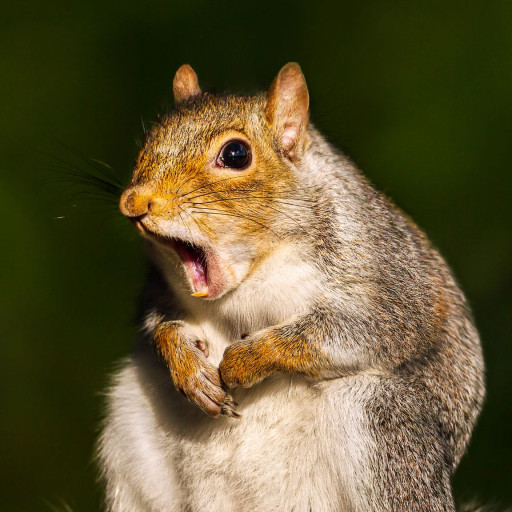Highlights: In a bizarre turn of events last month, UK Prime Minister Rishi Sunak announced that he would ban American XL bullies, a type of pit bull-shaped dog that had recently been implicated in a number of violent and sometimes deadly attacks.
XL bullies are perceived to be dangerous — but is that really rooted in reality?
If you don’t think that dog breed is a good predictor of behavior, you have not spent enough time around dogs.
For thousands of years dogs have been bred for specific purposes. These behaviors are innate. They do not need to be taught. Sure, you can train them to be better, but the behaviors are written all over their genes
My grandparents had shepherds. The dogs had never seen sheep or been taught anything about herding, but they would attempt to herd all my cousins when they were children, then get agitated when the children wouldn’t herd. Here’s some puppies doing it
Here’s some pointers pointing. They have not been taught this (and frankly I can’t imagine even training most dog breeds to do that)
Here’s a boxer dog boxing. Here’s one spinning. They aren’t taught this, and they all do it.
There’s hounds rolling in stink. There’s sight hounds and smell hounds. There’s retrievers retrieving, being irresistibly drawn to water, and carrying around things very gently. There’s huskies being extremely energetic and vocal.
I could go on.
Do you really think that dogs that have been bred to fight other dogs to the death and bear enormous amounts of pain (game) before giving up are not dangerous? You’re mental.
Sure they’re sweet to their owners. That’s because people who breed animals for blood sports are not the kind of people who would have trouble immediately removing from the gene pool any of their animals that are disloyal.
It’s not like it’s just pitbulls. Dobermans are implicated too. They’re guard dogs but for humans rather than predator animals.
People with agendas can play all kinds of statistical games to show what they want to show. In the scientific world, these kinds of tricks stand out. That’s why any non-trivial summary statistic is useless without a large text explaining the methodology.
This is one of those things that is so obvious it boggles my mind that people even question it.
Of course dogs that are bred to murder are dangerous.
It’s not just the genetic predisposition (which is arguably made worse with bully XLs due to so many of the lineage being bred from a small number of very aggressive specimens). It’s the size of them. They are orders of magnitude more dangerous than most other breeds when they go feral.
There is also definitely a factor at play where the sort of person to want a scary looking dog is also the sort of person who’s less likely to properly socialise and train them. But it’s mental to argue that say, a 7-foot tall gladiator is no more dangerous than a 5-foot tall gardener. Size and bite strength matters.
I do think there are more humane options available than just destroying them all. Muzzles in public; all dogs should really be on a lead in a public space, but especially v strong breeds; mandated training and chipping as a prerequisite of owning a dog; tougher laws that reflect if you own a deadly weapon on 4 legs that causes harm or death, you are responsible as if you carried out the attack yourself.
Absolutely.
My cat regularly draws blood. Cats are much less human bred than dogs, but, in any case he can’t really maul a child. Same with chihuahuas and plenty of other small dogs.
Your last paragraph seems pretty extreme to me. I agree in principle and do advocate for trying to remove these genes from the gene pool, which may involve careful breeding and/or letting them go extinct.
I’m curious if there’s a story behind that paragraph?
Not the person to whom you replied, but there are many stories behind that paragraph. The problem is that a dog bred to be strong is likely to be strong enough to ignore a leash when it wants to. A few minutes on your search engine of choice can give you headlines of pits and other powerful breeds getting away from their handlers even when leashed.
The resulting advocacy is that criminal culpability should still lie even in the absence of negligence on the part of the owner. In many states, tort liability will lie on a strict liability basis (i.e., the owner is liable for damages incurred by the victim of an animal attack even if the animal exhibited no prior dangerous behavior)–in other states, the owner must be aware of the danger of the animal, for instance from prior bites, before liability will attach. That’s generally not true in criminal cases, however, where theories usually require a finding of negligence due to the higher burden of proof and the higher stakes (i.e., incarceration).
The best analogy I can think of would be statutory rape–you can be guilty and incarcerated even if you consented, the victim consented, and you genuinely had no idea that the victim was below the statutory age. The position would be that we should adopt the same for animal attacks: You can (and should, advocates would argue) be incarcerated even if your animal injured someone through no fault of your own and you had no previous reason to believe the animal would become dangerous.
Reading about some of the attacks in which the owner exercised their best efforts to control the animal and failed, I can see the argument: Merely owning the animal at all is accepting responsibility for its actions, full stop. Personally, I think current negligence theory is basically sufficient for this (i.e., if the dog can get away from you, you have a duty to know that and prevent it), but the benefit of this kind of strict liability legislation would be that all the bickering in these threads about which breed is good, which breed is bad, and who knows and doesn’t know dogs would evaporate. Put your money where your mouth is. The dog you can count on never to kill someone is the dog that can’t.
Love, the owner of a small yappy type dog who is harmless because he’s tiny and trivially easy to overpower.
Not everything needs to be a crime. Strict liability in tort is more than adequate to compensate victims of animal injuries.
Criminal law is about intent. The defendant has to have intended the crime. How can a dog bite be intentional on the part of the human?
Ok. So I’m not sure why you seem to think I disagree with you.
That’s a huge extremely legalistic seeming argument that I can’t seem to see as a different argument than mine.
I wasn’t arguing at all, nor agreeing or disagreeing with anyone. Just talking through the reasoning, since you asked for the story to justify it. [Again, not the person you originally responded to.]
Asshole cat is biting me right now. We went on vacation for a few days, left him with a friend, and then had him stay alone for about 36 hours (with his automatic feeder and fancy waterer).
He’s just the most social cat I’ve ever had.
What a load. Most ppl (including you) don’t even know which dogs were breed for fighting. Anita’s (yes doge dog) were breed for bear hunting and fighting in the 1600s. Same for shar-peis.
Practically every dog breed at one point was breed for fighting.
Esit: I stand corrected
Doge is not an akita, she’s a shiba inu.
I think you meant Akitas, but it autocorrected. The doge dog is actually a Shiba Inu, which are much smaller than Akitas
That’s quite the non sequitur.
Statistically pit bulls and closely related breeds are responsible for the most attacks. Anyone bringing human race into this is silly.
I don’t think the occurrence of attacks are more, just the severity. It’s probably less likely a chihuahua attack causes enough damage to warrant a report. Pitbulls are dangerous, not because they’re more prone to attack, but because when they do, they cause a lot more physical damage.
I think the occurrence is somewhat more. While some smaller dogs may be aggressive and are aggressive, they also tend to learn rapidly they do not have the size to be aggressive. Thus that trait becomes less common overall.
I think that people should be able to own them, but they need to be put in the same class as foxes, wolves, hyenas and wild dogs. I met a sweet pit bull at a friend’s house but the first thing she did was jump on me and scratch my stomach, which drew blood.
My friend met a sweet pitbull, and then it bit her on the neck. They aren’t just strong, they are unpredictable as hell.
people who cannot control their dog when outside, should rethink owning said dog.
It’s more complicated than that. If your can’t stop your lab from licking a stranger to death, that’s completely different from not being able to stop your pitbull or doberman from mauling a toddler.
Yes, people should be responsible dog owners, but only certain breeds regularly snap and kill or maim.
Nah either way it’s just negligence. It’s up to the dog owner to take appropriate steps, or face liability.
When you may not be able to get homeowners insurance because of the dog you own, it’s not likely to be an issue is prejudice. They do everything by statistics.
the thing about prejudice in the title is absolutely, deeply, fantastically true. I, too, think that it’s a prejudice to believe that is possible to control animals bred with the precise intent to maul.
This is the best summary I could come up with:
In a bizarre turn of events last month, UK Prime Minister Rishi Sunak announced that he would ban American XL bullies, a type of pit bull-shaped dog that had recently been implicated in a number of violent and sometimes deadly attacks.
That came shortly after videos emerged of a dog attack that injured an 11-year-old girl named Ana Paun in Birmingham, England.
Noel King, host of Vox’s daily news podcast Today, Explained, wanted to know more about why this dog breed is so controversial.
It was all kind of folklore, myth, and media sensationalism — and that gave me a window to talk about a lot of other different subjects, using the pit bull as a lens.
Because they were popular and they were associated with these social changes, people believed that they bit more and that they were kind of poisonous and they transmitted rabies.
In the early ’90s in Boston, there was a pilot program where ownership of a pit bull was used as kind of an excuse for a stop and frisk with law enforcement.
The original article contains 1,944 words, the summary contains 178 words. Saved 91%. I’m a bot and I’m open source!
One thing that bears mention is that dogs are humankind’s best friend. They have a special and sacrosanct relationship to humans; in our evolution, in our history, in our law, in our communities, in our homes, and daily in our families. I’m skeptical of any government action intended to interfere with a person’s right to keep whatever dog as they fit, absent inhumane treatment. I view breed bans the same way I view bans on oral or anal sex, homosexual sex, gay marriage, interracial marraige, and abortion: so central to family decisionmaking, and private, and personal as to be beyond the government’s reach. In other words, don’t come talking about banning breeds and then say any hypocritical bullshit about how you love small government, freedom, or liberty. Like if you have ever said “Don’t Tread on Me!” and you want to ban people having dog they want, you need to stfu because you sound so obviously stupid.
Is it animal cruelty if i simply do not get a pitbull? If a group of people dont get one? At what point does it become cruel to breed less and less pitbulls?
Pretty sure that’s the opposite of cruelty mate. Dogs need a loving home and if you can’t take care of it then we shouldn’t make more. More people should spay and neuter but they don’t.
So lets stop breeding them
I’m not breeding them their dogs they fuck.
People need to spay or neuter their animals.
Me who lives in a part of the country with wild dog packs: yes, that would be nice.
deleted by creator
deleted by creator
deleted by creator
The audacity of the people in these comments is just 👨🍳🤌 Mamma mia. I mean it’s a real grab bag of crazy in here. You got tankies trying to equate black people to dogs, galaxy brains who think banning pits is a solution, and the rest of us just stuck in the middle asking ‘wtf?’.
The race thing is explained in the article











